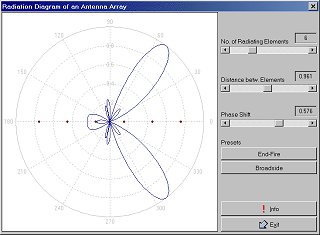| Wireles Networking is a practical guide to planning and building low-cost telecommunications infrastructure. See the editorial for more information.... |

|

Home  Antennas and Transmission Lines Antennas and Transmission Lines  Antennas Antennas  Beamwidth, Sidelobes and Nulls Beamwidth, Sidelobes and Nulls |
||||
| See also: Antennas & Radiation Patterns | ||||






|
||||
|
Beamwidth, Sidelobes and NullsAn antenna's beamwidth is usually understood to mean the half-power beamwidth. The peak radiation intensity is found, and then the points on either side of the peak which represent half the power of the peak intensity are located. The angular distance between the half power points is defined as the beamwidth. Half the power expressed in decibels is -3dB, so the half power beamwidth is sometimes referred to as the 3dB beamwidth. Both horizontal and vertical beamwidths are usually considered.
No antenna is able to radiate all the energy in one preferred direction. Some is inevitably radiated in other directions. These smaller peaks are referred to as sidelobes, commonly specified in dB down from the main lobe. In an antenna radiation pattern, a null is a zone in which the effective radiated power is at a minimum. A null often has a narrow directivity angle compared to that of the main beam. Thus, the null is useful for several purposes, such as suppression of interfering signals in a given direction.
|
||||
Home  Antennas and Transmission Lines Antennas and Transmission Lines  Antennas Antennas  Beamwidth, Sidelobes and Nulls Beamwidth, Sidelobes and Nulls |
||||
Last Update: 2007-01-25


